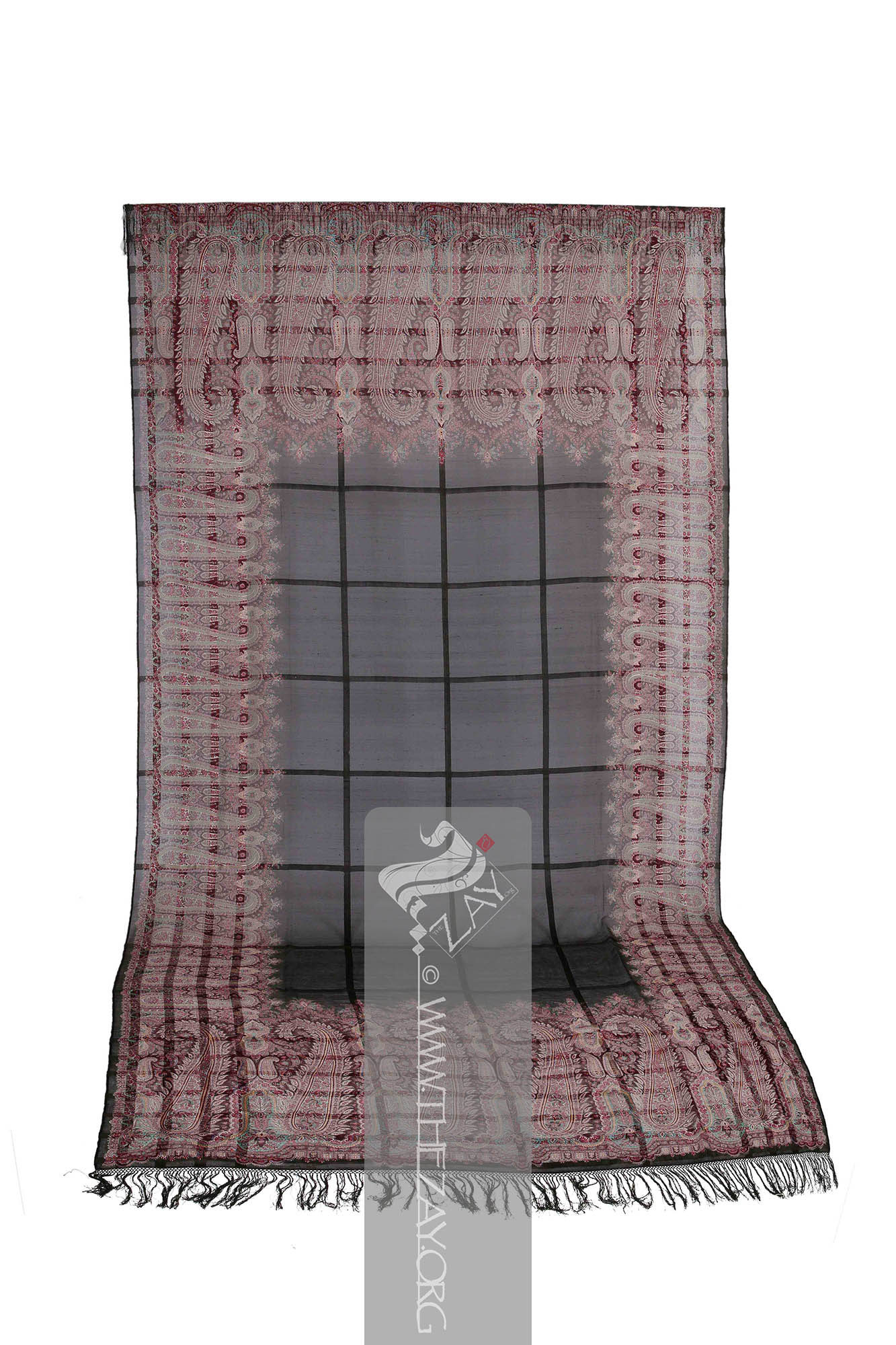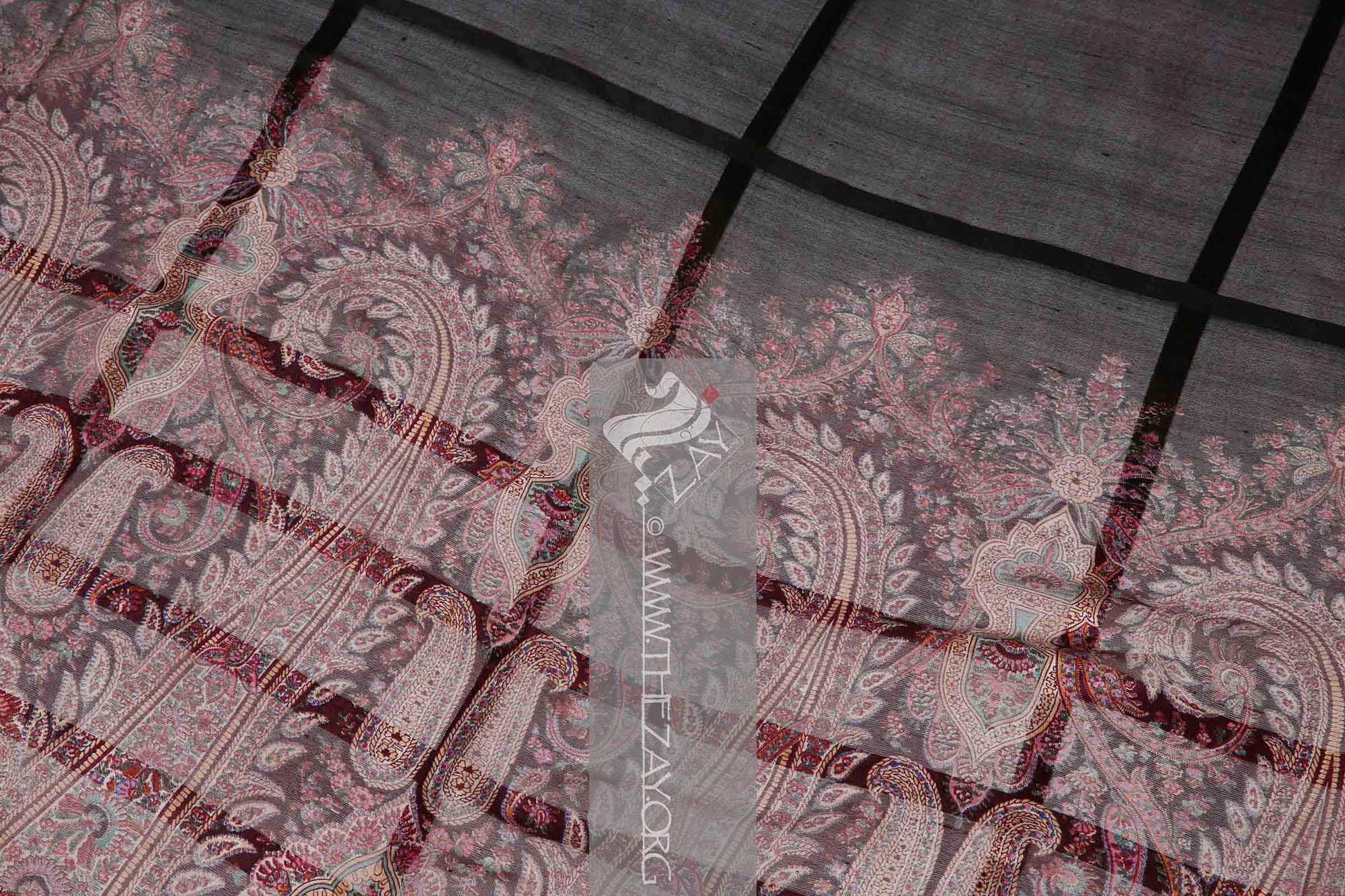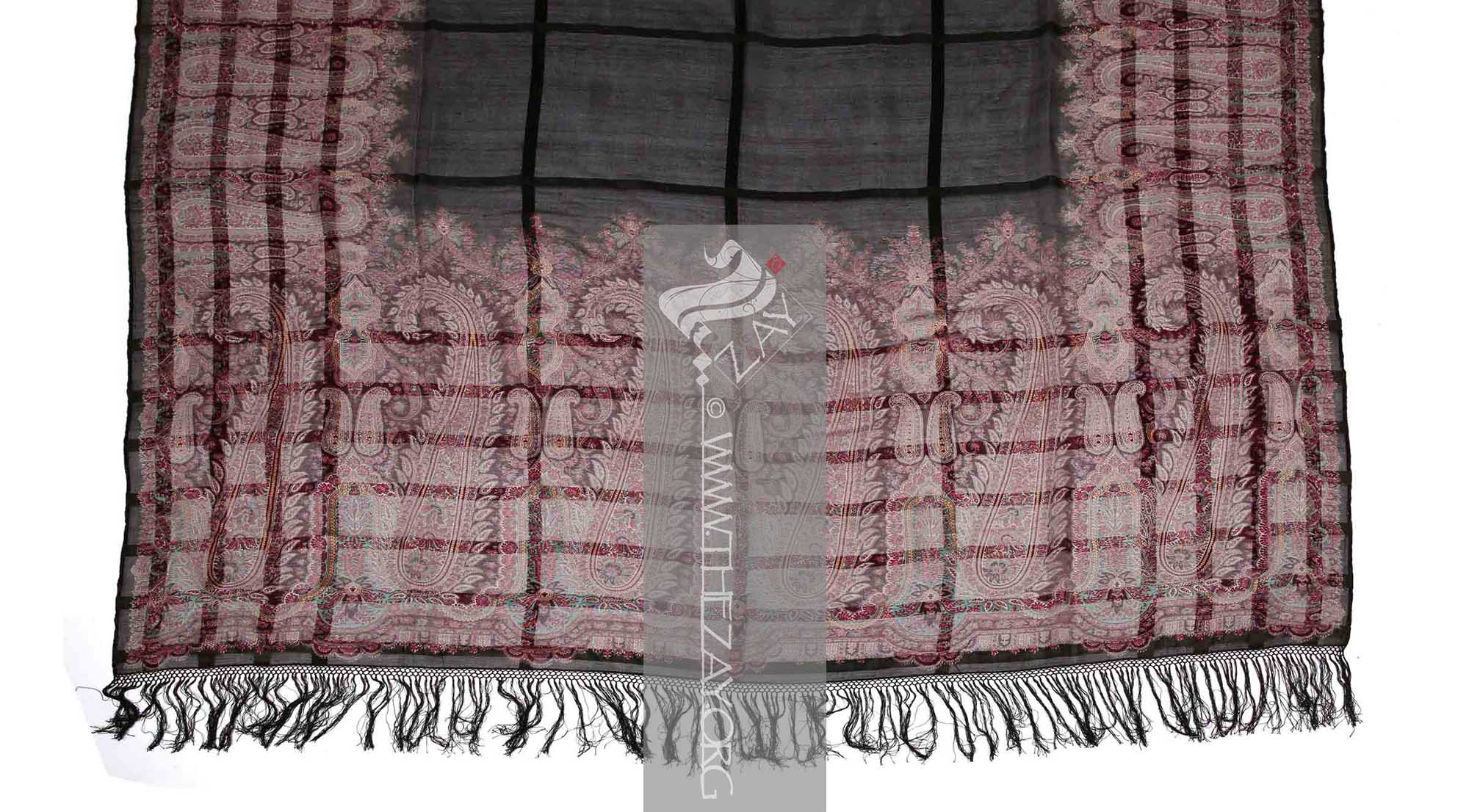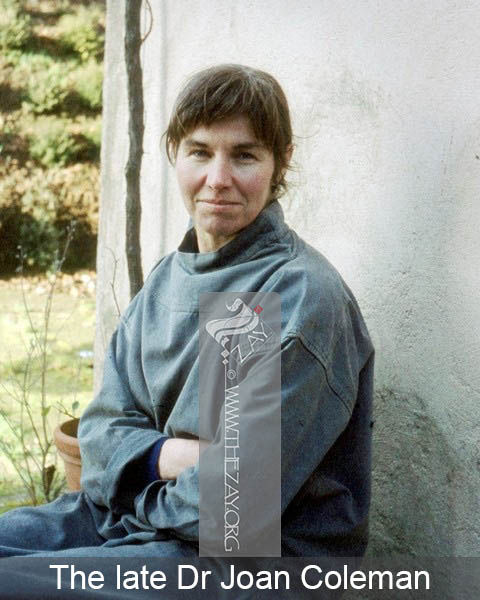Object NoteSet of a duo with (
ZI2000.500761 EUROPE).
Object HistoryThis rectangular Victorian silk (
gauze
Gauze: (English), very fine wire mesh transparent fabric of silk, linen, or cotton.) printed (
shawl
Shawl: (Persian: shāl from Hindi: duśālā – Shoulder Mantle), a shawl is a South Asian version of a scarf worn or wrapped loosely over the shoulders and is usually made of wool. ) dating back to the mid-19th century was originally part of a duo along with another similar piece –
ZI2020.500761 EUROPE – in the Dr Joan Coleman Collection. It was first purchased at a Philips auction on November 8, 1979. Later The
Zay
Zay: (Arabic: costume, Pl. azyaā’), a set of clothes in a style typical of a particular country or historical period. Initiative managed to acquire it from Kerry Taylor Auctions in the year 2020.
Dr Joan Coleman began collecting shawls in 1976 and developed her lifelong passion for collecting. She was a regular at the London salesrooms of Christie’s, Sotheby’s, and Phillips – three of the most outstanding auction houses of the period in the world – getting to know the dealers and learning in the process. She acquired vast knowledge and dedicated hours carefully cataloguing her ever-growing collection. She intended to loan her collection to different museums and institutions for the benefit of learning and education. Her collection is one of the largest and the finest private
shawl
Shawl: (Persian: shāl from Hindi: duśālā – Shoulder Mantle), a shawl is a South Asian version of a scarf worn or wrapped loosely over the shoulders and is usually made of wool. collections to have ever graced the world with shawls ranging from Kashmir,
Paisley
Paisley: (Scottish Gaelic, Pàislig: a town in Scotland), often called buta, boteh, amli, or kalgi in the subcontinent and kazuwah in Arabic, is a Persian tear drop motif with a curved end specially in textiles. Its popularity and subsequent local production in 18th century at Paisley are responsible for its nomenclature., Edinburgh, Norwich, France, and Iran.
Object Features This wine-red
shawl
Shawl: (Persian: shāl from Hindi: duśālā – Shoulder Mantle), a shawl is a South Asian version of a scarf worn or wrapped loosely over the shoulders and is usually made of wool. is a rectangular Victorian piece printed on silk
gauze
Gauze: (English), very fine wire mesh transparent fabric of silk, linen, or cotton. emulating the style of the (
long_shawl
Long_Shawl
Shawl: (Persian: shāl from Hindi: duśālā – Shoulder Mantle), a shawl is a South Asian version of a scarf worn or wrapped loosely over the shoulders and is usually made of wool. : (Synonym: Kirking Shawl
Shawl: (Persian: shāl from Hindi: duśālā – Shoulder Mantle), a shawl is a South Asian version of a scarf worn or wrapped loosely over the shoulders and is usually made of wool. ), European versions of and inspired by Kashmiri double shawl
Shawl: (Persian: shāl from Hindi: duśālā – Shoulder Mantle), a shawl is a South Asian version of a scarf worn or wrapped loosely over the shoulders and is usually made of wool. s in wool or silk manufactured locally in Europe. As a part of the trousseau for aristocratic women, it was often used at their first post-wedding church services and christenings. ) from the first quarter of the 19th century. It was part of a set of a duo at the Dr Joan Coleman collection with another similar piece –
ZI2020.500761 EUROPE – which is also a part of The
Zay
Zay: (Arabic: costume, Pl. azyaā’), a set of clothes in a style typical of a particular country or historical period. Initiative collection.
The silk
gauze
Gauze: (English), very fine wire mesh transparent fabric of silk, linen, or cotton. is treated with (quadrilled) weave giving the entire field an all-over chequered design. The printed element on the
shawl
Shawl: (Persian: shāl from Hindi: duśālā – Shoulder Mantle), a shawl is a South Asian version of a scarf worn or wrapped loosely over the shoulders and is usually made of wool. is distributed in a pattern similar to that of the long shawls. There are two broad (
phala
Phāla: (Etymological origin: Possibly Indo Persian), the wider layer of pattern that forms the border at each warp
Warp: One of the two basic components used in weaving which transforms thread or yarns to a piece of fabric. The warp is the set of yarns stretched longitudinally in place on a loom before the weft
Weft: one of the two basic components used in weaving that transforms thread or yarns into a piece of fabric. It is the crosswise thread on a loom that is passed over and under the warp threads. is introduced during the weaving process. end or head of a shawl
Shawl: (Persian: shāl from Hindi: duśālā – Shoulder Mantle), a shawl is a South Asian version of a scarf worn or wrapped loosely over the shoulders and is usually made of wool. . ) with six elongated (
buta
Būta: (Anglicized Persian: boteh – Pinecone shaped motif), known as paisley
Paisley: (Scottish Gaelic, Pàislig: a town in Scotland), often called buta, boteh, amli, or kalgi in the subcontinent and kazuwah in Arabic, is a Persian tear drop motif with a curved end specially in textiles. Its popularity and subsequent local production in 18th century at Paisley are responsible for its nomenclature. in English it is the almond or pinecone-shaped motif, especially in textiles. It is believed to have originated from the Cyprus tree a Zoroastrian symbol for life and eternity. In the current Indian context, however, it simply means motif.) or (
paisley
Paisley: (Scottish Gaelic, Pàislig: a town in Scotland), often called buta, boteh, amli, or kalgi in the subcontinent and kazuwah in Arabic, is a Persian tear drop motif with a curved end specially in textiles. Its popularity and subsequent local production in 18th century at Paisley are responsible for its nomenclature.) and a slightly narrower (hashiya) with similar paisleys but on a smaller scale. Unlike long shawls, the
phala
Phāla: (Etymological origin: Possibly Indo Persian), the wider layer of pattern that forms the border at each warp
Warp: One of the two basic components used in weaving which transforms thread or yarns to a piece of fabric. The warp is the set of yarns stretched longitudinally in place on a loom before the weft
Weft: one of the two basic components used in weaving that transforms thread or yarns into a piece of fabric. It is the crosswise thread on a loom that is passed over and under the warp threads. is introduced during the weaving process. end or head of a shawl
Shawl: (Persian: shāl from Hindi: duśālā – Shoulder Mantle), a shawl is a South Asian version of a scarf worn or wrapped loosely over the shoulders and is usually made of wool. . in this
shawl
Shawl: (Persian: shāl from Hindi: duśālā – Shoulder Mantle), a shawl is a South Asian version of a scarf worn or wrapped loosely over the shoulders and is usually made of wool. lacks any (
tanjir
Tanjīr: (Possibly Persian: zanjir: Chain), a narrow layer of pattern that forms the border and runs above and below the wider layer. ).
The main elongated paisleys on the
phala
Phāla: (Etymological origin: Possibly Indo Persian), the wider layer of pattern that forms the border at each warp
Warp: One of the two basic components used in weaving which transforms thread or yarns to a piece of fabric. The warp is the set of yarns stretched longitudinally in place on a loom before the weft
Weft: one of the two basic components used in weaving that transforms thread or yarns into a piece of fabric. It is the crosswise thread on a loom that is passed over and under the warp threads. is introduced during the weaving process. end or head of a shawl
Shawl: (Persian: shāl from Hindi: duśālā – Shoulder Mantle), a shawl is a South Asian version of a scarf worn or wrapped loosely over the shoulders and is usually made of wool. . are separated by an elaborate floral design arranged in a very geometric manner forming the (
jaal
Jaal: (Sanskrit: jaal – A net, web, or a mesh), the decoration which fills the ground between the paisley
Paisley: (Scottish Gaelic, Pàislig: a town in Scotland), often called buta, boteh, amli, or kalgi in the subcontinent and kazuwah in Arabic, is a Persian tear drop motif with a curved end specially in textiles. Its popularity and subsequent local production in 18th century at Paisley are responsible for its nomenclature. cones at the heads of a shawl
Shawl: (Persian: shāl from Hindi: duśālā – Shoulder Mantle), a shawl is a South Asian version of a scarf worn or wrapped loosely over the shoulders and is usually made of wool. .
). Each unit of the
jaal
Jaal: (Sanskrit: jaal – A net, web, or a mesh), the decoration which fills the ground between the paisley
Paisley: (Scottish Gaelic, Pàislig: a town in Scotland), often called buta, boteh, amli, or kalgi in the subcontinent and kazuwah in Arabic, is a Persian tear drop motif with a curved end specially in textiles. Its popularity and subsequent local production in 18th century at Paisley are responsible for its nomenclature. cones at the heads of a shawl
Shawl: (Persian: shāl from Hindi: duśālā – Shoulder Mantle), a shawl is a South Asian version of a scarf worn or wrapped loosely over the shoulders and is usually made of wool. .
is composed of a temple steeple arch with two small paisleys on top placed back-to-back. This is followed by a stylized double tear drop that finally gives way to a flowing (
palmette
Palmette: (French: Palmette – Small palm, synonym Greco-Roman: Anthemion), a decorative element, motif, or ornament particularly pertaining to designs of architecture and decorative arts that has radiating petals resembling a palm leaf. It is believed to have originated in ancient Egypt and had subsequently reached far and wide. ).
Both the
phala
Phāla: (Etymological origin: Possibly Indo Persian), the wider layer of pattern that forms the border at each warp
Warp: One of the two basic components used in weaving which transforms thread or yarns to a piece of fabric. The warp is the set of yarns stretched longitudinally in place on a loom before the weft
Weft: one of the two basic components used in weaving that transforms thread or yarns into a piece of fabric. It is the crosswise thread on a loom that is passed over and under the warp threads. is introduced during the weaving process. end or head of a shawl
Shawl: (Persian: shāl from Hindi: duśālā – Shoulder Mantle), a shawl is a South Asian version of a scarf worn or wrapped loosely over the shoulders and is usually made of wool. . and the hashiya have similar elaborate yet intricate designs that are (screen_printed) in an array of vibrant colours – pink, blue, green, orange, and beige. The finishing touch to the
shawl
Shawl: (Persian: shāl from Hindi: duśālā – Shoulder Mantle), a shawl is a South Asian version of a scarf worn or wrapped loosely over the shoulders and is usually made of wool. is rendered by a series of fringed (
macrame
Macrame: makrəˌmā: (Arabic: karam: tree with dangling grapes), ornamental fringe. The art of knotting cord or string in patterns to make decorative articles. Earliest recorded uses of macramé-style knots as decoration appeared in Babylonian and Assyrian carvings.Macrame
Macrame: makrəˌmā: (Arabic: karam: tree with dangling grapes), ornamental fringe. The art of knotting cord or string in patterns to make decorative articles. Earliest recorded uses of macramé-style knots as decoration appeared in Babylonian and Assyrian carvings.: (French: macramé – A hand-knotted textile from Turkish: makrama – table spread or towel, from Arabic: miqrama – bedspread possibly with knotted hanging fringes resembling dangling grapes or karam in Arabic) A form of textile or fringe made by a knotting cord in geometrical patterns possibly originating in Babylon and Assyria.) tassels of
satin
Sātin: (Arabic: Zaytuni: from Chinese port of Zayton in Quanzhou province where it was exported from and acquired by Arab merchants), one of the three basic types of woven fabric with a glossy top surface and a dull back. Originated in China and was fundamentally woven in silk. (quadrilles) stitched to the
shawl
Shawl: (Persian: shāl from Hindi: duśālā – Shoulder Mantle), a shawl is a South Asian version of a scarf worn or wrapped loosely over the shoulders and is usually made of wool. .
Although briefly, it may look like it had been (block_printed), especially the body, however, the execution of the intricate design elements leaves no doubt about its
screen_printing
Screen_printing: (Synonym: Silk_screen_printing), a printing technique that originated in China during the Song Dynasty – 960-1279 AD – uses a mesh stencil to transfer ink onto a substrate. Adopted and developed further by its neighbours like Japan its first European application on textiles was in the 18th century before becoming commercially popular. production procedure.
As women’s fashion changed from long flowing skirts that paired well with shawls to (bustled) (
crinolines
Crinolines: (Latin: crinis – hair, linum – thread, Synonym – Hoop skirt), a hooped or structured petticoat made of a stiff fabric which is composed of horsehair and cotton or linen thread. It was designed to hold a woman’s skirt out and became popular in the 19th century in Europe and the USA.) from the 1860s – the 70s and the subsequent rise of capes and jackets, the
shawl
Shawl: (Persian: shāl from Hindi: duśālā – Shoulder Mantle), a shawl is a South Asian version of a scarf worn or wrapped loosely over the shoulders and is usually made of wool. industry in Europe, as well as the subcontinent, suffered a major setback. This change in fashion coupled with the Franco-Prussian War that disrupted trade between Europe and India made the original pieces from Kashmir far more expensive resulting in the loss of patronage of the aristocracy. With high fashion losing interest, even the demand for the machine – (
jacquard
Jacquard: (After Joseph M Jacquard a French weaver and inventor), is referred to both an apparatus with perforated cards invented by the aforementioned Joseph M Jacquard in 1804 fitted to a loom enabling complex intricate weaving patterns and the brocaded fabric woven on a jacquard loom. ) loom–woven fabric for the mass market suffered a loss. To keep themselves afloat, weavers thus started producing machine-woven printed fabrics at an affordable rate as a last-ditch effort to keep themselves significant.








